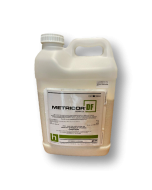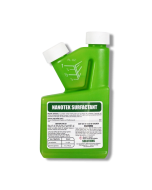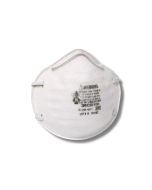Gain access to personalized product screening, the best pricing, rewards, and more!



application2
Metricor DF Herbicide
Metricor DF Herbicide is an excellent season long pre-emergent and post-emergent herbicide against many broadleaf weeds in field crops and bermudagrass.
Metricor DF Herbicide, manufactured by United Phosphorous, is a foundational pre-emergent and post-emergent product that provides powerful broad-spectrum weed control in various crops and established bermudagrass.
As a water-dispersible granule formulation it easily mixes with water to treat broadleaf and grassy weeds such as bluegrass (poa annua), pigweed, and fleabane within 3-28 days.
Metricor DF Herbicide provides a wide range of control over the toughest of weeds by utilizing the active ingredient metribuzin 75.0%. With this product it makes weed management in field corn, soybeans, established bermudagrass, and more relatively simple.
Tools Needed
To apply Metricor DF Herbicide, you will need to use a spray rig or chemigation equipment.
How to Use
- Step 1: Determine how much Metricor DF Herbicide to use by measuring the square footage of the treatment area. To do this, measure the length and width of the treatment area in feet then multiply them together (length X width = square footage). For acreage, take the square footage and divide it by one acre (square footage / 43,560 sq. ft. = acres). For broadcast applications to alfalfa and sainfoin use 1/3 to 1 1/3 lb. of Metricor DF Herbicide in 10 of water per acre. For use on mixed stands of alfalfa and grasses, apply 2/3 to 1 lb. of product in 10 gallons of water per acre. For preplant incorporated applications to transplant tomatoes, use 1/3 to 2/3 lb. of product in 10 to 40 gallons of water per acre. For post-emergent weed control as a broadcast spray in tomatoes, use 1/3 to 2/3 lb. of product in 20 gallons of water per acre. For direct sprays on emerged weeds in tomatoes, use 2/3 to 1 1/3 lb. of product in 20 gallons of water per acre. For applications on established or actively growing bermudagrass, apply 2/3 lb. of product in 40 gallons of water per acre.
- Step 2: First fill the spray tank 1/4 to 1/3 full with clean water, then add the proper amount of Metricor DF Herbicide. Mix thoroughly and add the remaining half of water to fill the spray tank. Agitation is necessary during mixing and spraying operations to ensure a uniform spray mixture.
- Step 3: Ensure that the sprayer is accurately calibrated before applying Metricor DF Herbicide mixture. Thoroughly spray the top and bottom of weeds until wet, but not to the point of runoff. Avoid spray skips and gaps which allow weeds to grow in untreated soil. Be sure to also avoid spray overlaps.
Where to Use
Metricor DF Herbicide can be used on certain grasses and broadleaf weeds in alfalfa and sainfoin, asparagus, carrots, field corn, garbanzo beans, lentils and peas, potatoes, soybeans, spring and winter barley and winter wheat, sugarcane, sweet corn, and tomatoes. It may also be used on established bermudagrass turf.
Do not use on other crops grown for food or forage.
Not for use in commercial greenhouses, nurseries, on sod farms, or on grass grown for seed.
When to Use
Use Metricor DF Herbicide when weeds are present or prior to their emergence in listed areas on days when rainfall is expected to occur at least 24 hours after application. If no rainfall is present you irrigate treated areas yourself or avoid doing so when rainfall is expected at least 30 days after application.
Do not rotate any crop not listed on this label for 18 months following application of this product.
Do not apply to dormant turf in the transitional bermudagrass growing zones which are or can be expected to be adversely affected by cold weather stress.
Safety Information
Metricor DF Herbicide is safe to use around children and pets when applied according to the product label instructions. Always wear the proper personal protective equipment (PPE) when mixing and applying this product.
Do not enter or allow others to enter treated area until sprays have dried.
Special Considerations
Do not apply more than twice per season to actively growing bermudagrass turf. Applications may result in temporary discoloration, which turf soon outgrows.
| Availability | Online |
| Restricted Use | No |
| Shipping Restrictions * = not registered** = restricted use | 10 Pound: AK*, MA**, VT**, WA** |
| Brand | UNITED PHOSPHORUS |
| Keith's Pro Tips | “Set PTO-driven equipment (tillers, cultivators, hoes) to cut 2 to 3 inches deep and space rotors to provide a clean sweep of the soil. PTO equipment should not be operated at a speed greater than 4 miles per hour.” |
| Product Drawbacks | Metricor DF Herbicide is intended only for commercial applicators and has varying grazing restrictions per treated area. |
| Target Pests | Ageratum, Alexandergrass, Annual bluegrass, Annual mustard, Annual polemonium, Annual ryegrass, Barnyardgrass, Bedstraw, Bittercress, Black nightshade, Blackgrass, Blue mustard, Bluegrass, Bristlegrass, Bristly foxtail, Bristly starbur, Broadleaf panicum, Broadleaf signalgrass, Bromus species, Browntop millet, Browntop panicum, Buffalobur, Bulbous bluegrass, Burcucumber, Buttercup, Butterweed, Canada thistle, Canarygrass, Carolina foxtail, Carolina geranium, Carpetweed, Catchweed, Cheat, Cheatgrass, Cheeseweed, Chickweed, Cocklebur, Coffee senna, Common chickweed, Common cocklebur, Common dandelion, Common lambsquarters, Common purslane, Common ragweed, Common sunflower, Common yellow woodsorrel, Conical catchfly, Copperleaf, Corn cockle, Corn speedwell, Corn spurry, Cow cockle, Crabgrass, Cressleaf groundsel, Crowfootgrass, Cudweed, Cupgrass, Curly dock, Cutleaf eveningprimrose, Dallisgrass, Dandelion, Dayflower, Dogfennel, Downy brome, Eastern black nightshade, Eclipta, Entireleaf morningglory, Fall panicum, Fanweed, Field bindweed, Field horsetail, Field pennycress, Field pepperweed, Field sandbur, Fireweed, Flixweed, Flora's paintbrush, Florida beggarweed, Florida pusley, Foxtail, Foxtail barley, Fumitory, Galinsoga, Garden spurge, German moss, Giant foxtail, Giant ragweed, Goosefoot, Goosegrass, Graceful spurge, Green foxtail, Gromwell, Groundsel, Guineagrass, Hairy nightshade, Hemp sesbania, Henbit, Hialoa, Hila hila, Hop clover, Hophornbeam copperleaf, Horsenettle, Horseweed, Indian mustard, Italian ryegrass, Ivyleaf morningglory, Ivyleaf speedwell, Jacob's-ladder, Japanese brome, Jim Hill mustard, Jimsonweed, Johnsongrass (seedling), Junglerice, Knawel, Knotweed, Koa haole, Kochia, Ladysthumb, Lambsquarters, Large crabgrass, Little barley, Little mallow, Littleseed canarygrass, London rocket, Madwort, Mallow, Marestail, Mayweed, Meadow salsify, Mexicanweed, Miners lettuce, Morningglory, Morningglory species, Mouse barley, Mouseear chickweed, Mustard, Nettleleaf goosefoot, Nutsedge, Palmer amaranth, Parsley-piert, Pennsylvania smartweed, Pennycress, Pepperweed, Pigweed, Pineappleweed, Pitted morningglory, Plushgrass, Poorjoe, Prickly lettuce, Prickly sida, Prostrate knotweed, Prostrate pigweed, Purple deadnettle, Purple mustard, Purslane, Rabbitfootgrass, Rattail fescue, Rattlepod, Red deadnettle, Red rice, Red sorrel, Redroot pigweed, Redstem filaree, Redweed, Rescuegrass, Ricegrass, Richardia species, Ripgut brome, Robust foxtail, Robust purple foxtail, Rough fleabane, Russian thistle, Ryegrass, Sandbur, Sesbania, Shattercane, Shepherdspurse, Sicklepod, Silversheath knotweed, Smallflower buttercup, Smallflower morningglory, Smallseed false flax, Smartweed, Smooth brome, Smooth crabgrass, Smooth pigweed, Sowthistle, Spiny amaranth, Spiny sowthistle, Spleen amaranth, Spotted burclover, Spotted spurge, Sprangletop, Spring whitlowgrass, Spurred anoda, Spurweed, Stinkgrass, Sunflower, Swamp smartweed, Tall morningglory, Tall waterhemp, Tansymustard, Tarweed, Tarweed fiddleneck, Teaweed, Texas panicum, Toadflax, Treacle mustard, Tumble mustard, Velvetleaf, Venice mallow, Vernal whitlowgrass, Vetch, Virginia pepperweed, Volunteer fine fescue, Volunteer orchardgrass, Volunteer perennial bluegrass, Volunteer perennial ryegrass, Volunteer ryegrass, Volunteer sorghum, Volunteer tall fescue, Volunteer wheat, Waterhemp, White clover, White cockle, Wild barley, Wild buckwheat, Wild euphorbia, Wild mustard, Wild oat, Wild poinsettia, Wild radish, Wild sunflower, Wild turnip, Windgrass, Winter oat, Wiregrass, Witchgrass, Yellow foxtail, Yellow nutsedge, and Yellow rocket. |
| Application Equipment | Chemigation System, Spray Rig |
| Application Methods | Broadcast Spray, Overhead Sprinkler Irrigation |
| Active Ingredient | Metribuzin 75.0% |
| Product Type | Herbicide |
| Formulation | Water Dispersible Granule (WDG) |
| Application Rate | For broadcast applications to alfalfa and sainfoin use 1/3 to 1 1/3 lb. of Metricor DF Herbicide in 10 of water per acre. For use on mixed stands of alfalfa and grasses, apply 2/3 to 1 lb. of product in 10 gallons of water per acre. For preplant incorporated applications to transplant tomatoes, use 1/3 to 2/3 lb. of product in 10 to 40 gallons of water per acre. For post-emergent weed control as a broadcast spray in tomatoes, use 1/3 to 2/3 lb. of product in 20 gallons of water per acre. For direct sprays on emerged weeds in tomatoes, use 2/3 to 1 1/3 lb. of product in 20 gallons of water per acre. For applications on established or actively growing bermudagrass, apply 2/3 lb. of product in 40 gallons of water per acre. |
| Shelf Life | Metricor DF Herbicide will last for 3 years when stored in a cool, dry place away from other pesticides, fertilizers, food, and feed. |
| Yield | 10 lbs. of Metricor DF Herbicide will treat 135 acres at 2/3 lb. of product per acre rate. |
| Use Sites | Outdoors |
| Time to Kill | Metricor DF Herbicide will control weeds within 3-28 days after application. |
| Comparable Products | Metribuzin Herbicide |
| EPA Registration # | 70506-103 |
| Restricted Use | No |
|---|---|
| Shipping Restrictions | AK, MA |
| Availability | Online |
| Signal Word | CAUTION |
| Keith's Pro Tip | “Set PTO-driven equipment (tillers, cultivators, hoes) to cut 2 to 3 inches deep and space rotors to provide a clean sweep of the soil. PTO equipment should not be operated at a speed greater than 4 miles per hour.” |
| Time to Kill | Metricor DF Herbicide will control weeds within 3-28 days after application. |
| Chemical Type | Herbicide |
| Formulation | Water Dispersible Granule (WDG) |
| Application Methods | Broadcast Spray, Overhead Sprinkler Irrigation |
| Product Drawbacks | Metricor DF Herbicide is intended only for commercial applicators and has varying grazing restrictions per treated area. |
| Active Ingredient | Metribuzin 75.0% |
| Application Equipment | Chemigation System, Spray Rig |
| Mix Rate | For broadcast applications to alfalfa and sainfoin use 1/3 to 1 1/3 lb. of Metricor DF Herbicide in 10 of water per acre. For use on mixed stands of alfalfa and grasses, apply 2/3 to 1 lb. of product in 10 gallons of water per acre. For preplant incorporated applications to transplant tomatoes, use 1/3 to 2/3 lb. of product in 10 to 40 gallons of water per acre. For post-emergent weed control as a broadcast spray in tomatoes, use 1/3 to 2/3 lb. of product in 20 gallons of water per acre. For direct sprays on emerged weeds in tomatoes, use 2/3 to 1 1/3 lb. of product in 20 gallons of water per acre. For applications on established or actively growing bermudagrass, apply 2/3 lb. of product in 40 gallons of water per acre. |
| Use Sites | Outdoors |
| Yield | 10 lbs. of Metricor DF Herbicide will treat 135 acres at 2/3 lb. of product per acre rate. |
| EPA Registration No. | 70506-103 |
| Shelf Life | Metricor DF Herbicide will last for 3 years when stored in a cool, dry place away from other pesticides, fertilizers, food, and feed. |
| Comparable Products | Metribuzin Herbicide |
| Children or pets? | No |
| Property Characteristics | None |
*Price does not include freight. We guarantee our rate plus shipping will be less than anyone else's price.









